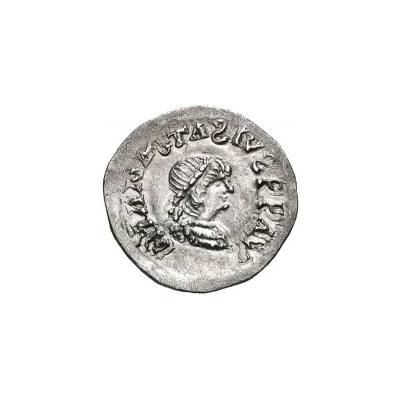


© Classical Numismatic Group, Inc.
¼ Siliqua In the name of Anastasius I and Theoderic; Sirmium; regular S with flat bust
| Silver | 0.86 g | 16 mm |
| Issuer | Gepid Kingdom |
|---|---|
| Type | Standard circulation coin |
| Years | 493-526 |
| Value | ¼ Siliqua |
| Currency | Siliqua (491-567) |
| Composition | Silver |
| Weight | 0.86 g |
| Diameter | 16 mm |
| Shape | Round (irregular) |
| Technique | Hammered |
| Demonetized | Yes |
| Updated | 2024-10-09 |
| Numista | N#150148 |
|---|---|
| Rarity index | 100% |
Reverse
Monogram of Theoderic with cross above and surrounded by legend.
Script: Latin
Lettering: VINVITA - A ROMAN
Translation:
Invicta Roma
Unconquered Rome
Edge
Plain
Comment
While the types struck in the name of Anastasius I (491-518) and Theoderic (475-526) were originally attributed to the Gepids, they were later proposed to be issues of the Ostrogoths, which became a widely-accepted theory. Even so, with the weights of these issues not matching the Ostrogothic weight standard set by Theoderic, and with the stylistic depictions matching Gepid issues struck in the name of other rulers, Metlich concluded that all these types are, in fact, issues of the Gepids, which many auction houses are in agreement with.The exact lettering of the surrounding legend may vary.
No date:
1) D N ANASTASIVS PP AVC / INVIT – A ROMA
2) D N ANASTASIVS P AV / IVINVICA - A RONAN
3) D N ANASTASIVS P AV / VINVICTA – A ROMANI
4) D N ANASTASIVS P AV / VINVITA - A ROMAN
5) D N ANASTAIVS PP AV / MINVICT - A ROMAD
Interesting fact
One interesting fact about this coin is that it was minted during a time of great political upheaval in the Gepid Kingdom. The coin was issued jointly in the names of Anastasius I and Theoderic, indicating a period of political tension and power-sharing between the two rulers. Additionally, the coin's design features a unique blend of Roman and barbarian influences, reflecting the cultural exchange and fusion that occurred during this time period.



